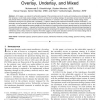Free Online Productivity Tools
i2Speak
i2Symbol
i2OCR
iTex2Img
iWeb2Print
iWeb2Shot
i2Type
iPdf2Split
iPdf2Merge
i2Bopomofo
i2Arabic
i2Style
i2Image
i2PDF
iLatex2Rtf
Sci2ools
TMC
2010
2010
Access Strategies for Spectrum Sharing in Fading Environment: Overlay, Underlay, and Mixed
—In this paper, we analyze the achievable capacity of the secondary service for overlay and underlay access strategies. We then propose a novel mixed access strategy in which in contrast to the underlay strategy, the secondary service transmits during the idle periods without considering the interference threshold constraint. In contrast to the overlay strategy, mixed strategy makes transmission during the busy periods with a probability pa subject to satisfying the interference threshold constraint. Parameter pa is a secondary service parameter, which can be adjusted based on the spectrum status. Moreover, we show that the secondary service can adjust pa to select appropriate access strategy with the objective of maximizing the achieved capacity based on the interference at the secondary service receiver, I, imposed by the primary service transmitter. The proposed spectrum-sharing technique developed in this paper based on I significantly reduces the system complexity comparing to t...
| Added | 31 Jan 2011 |
| Updated | 31 Jan 2011 |
| Type | Journal |
| Year | 2010 |
| Where | TMC |
| Authors | Mohammad G. Khoshkholgh, Keivan Navaie, Halim Yanikomeroglu |
Comments (0)

